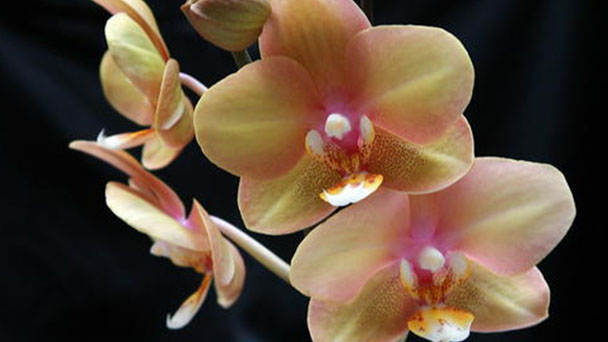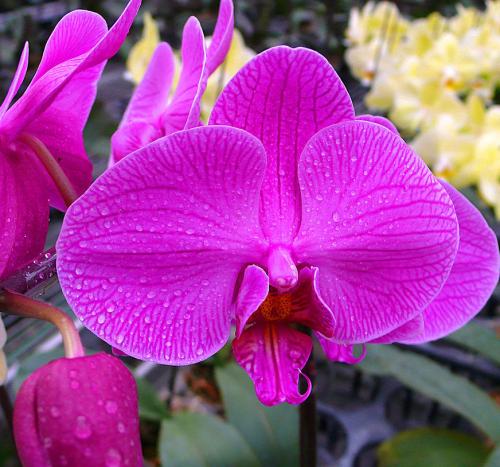Moth orchids: How to grow and care for Phalaenopsis
Written by Maggie
Sep 09 2021

Moth Orchids belong to the genus Moth Orchids of Orchidaceae, with perennial evergreen epiphytic herbaceous flowers. Moth orchids are named for their butterfly - like flowers. Moth Orchids are popular with people for their beautiful flowers and varied flower shapes and colors. Therefore, it is the most widely cultivated orchid in the world. How to grow and care for Moth Orchids? Let's look down together.
1. Pot care for growing moth orchids
When we grow and care for moth orchids, the growth substrates of Moth Orchids must be well drained and have certain water-retaining properties. Commonly used substrates are moss, fern root, bark, charcoal, ceramsite and so on.
Change the pot should be selected in the growing season of summer, the method is to pour out the plant first, remove the old cultivation matrix, and cut the aging and rotten roots, and then put a layer of charcoal grains in the new pot bottom, and then put the plant, fill in the new matrix, compaction pouring permeable.
The time to change the pot should depend on the substrate. The water moss substrate will rot in 1 to 2 years, and when it rots, it secretes very acidic substances, which will harm the air roots. When we grow and care for moth orchids, if not replaced in time, it will cause root rot. Therefore, water moss or bark as a substrate, cultivation 1 ~ 2 years to change the pot 1 times; Cultivation with coconut shell can be 2 ~ 3 years to change the pot once; Cultivation with ceramsite or charcoal can be 3 ~ 5 years for 1 time. But fertilizer should be applied frequently and lightly to compensate for the absence or absence of nutrients in these substrates.
2. Watering care for growing moth orchids
Moth orchids are prone to rot if they are exposed to rain or overwatered. Therefore, watering is the key to ensure its normal growth. When watering, avoid water splashing wet leaves, because water splashing is easy to cause rotten leaves, especially serious in winter. When we grow and care for moth orchids in spring and summer growth period, should be watered 1 times a day, spray 2 ~ 3 times; Autumn and winter, with the decrease of temperature, the amount of watering should gradually reduce, 2 ~ 5 days to water 1 times, and stop spraying, keep the basin soil slightly wet.
Domestic Moth Orchids can be sprayed 2 to 3 times a day when the weather is dry and the humidity is insufficient. When we grow and care for moth orchids in winter, when the temperature drops to 15 degrees below, it can not be watered, just every afternoon when the temperature turns high spray 1 time.
Watering or sprinkling, such as leaf retention of water, should be immediately used for cloth or dry paper dry or dry, in order to prevent the occurrence of stem and leaf decay; Summer and autumn seasons should be prevented from rain, to avoid causing decay.
3. Fertilization care for growing moth orchids
Because the organic fertilizer after application will produce a peculiar smell, affecting the bedroom health, fertilization is generally given priority with chemical fertilizer. Commonly used chemical fertilizers are potassium dihydrogen phosphate, diammonium phosphate and orchid fertilizer, application concentration of 0.1% ~ 0.2%, in the growing season 5 ~ 7 days topdressing 1 times; When we grow and care for moth orchids, apply topdressing once 20-30 days in slow growing season; Stop fertilizing in winter when the temperature drops below 15℃. In the process of cultivation, different growth periods, the type and proportion of fertilization are also different. The proportion of nitrogen, phosphorus and potassium fertilizer was 1:1:1 in the vegetative growth stage of medium and small seedlings. Large seedlings and flowering plants are 1:1.5:4.
4. Shading care for growing moth orchids
Moth Orchids thrive in summer, so shade should be used to prevent their leaves from burning. General shading 50% ~ 60%; The sun is also more intense in autumn, so 50% shading is still needed until autumn.

Moth Orchid - Most Common House Plant
5. Growing moth orchids care for pest and disease control
The diseases of Moth Orchids are mainly caused by poor ventilation and other factors. Common disease has soft rot disease, brown spot disease, anthracnose, virus disease, etc., can be used tobutianjin, chlorothalonil, polymycelium and sulfur mixture and other medicine 500 times diluent spray prevention and control. When we grow and care for moth orchids, improving ventilation conditions, preventing high temperature in summer and cold in winter are also effective measures to prevent soft rot.
The common pests are scale insects, red spiders, snails and so on. Red spider and scale insect can oxidize happy fruit or trichloride mite alcohol 800 ~ 1000 times liquid prevention and control, snail can be used in basin 4 next to the lime powder, catch in the evening or apply to kill snail medicine to prevent and control.
6. Temperature care for growing moth orchids
Temperature is one of the key factors for when we grow and care for Moth Orchids. The suitable temperature for the growth of Moth Orchids is 18 ~ 28℃, but in summer, the indoor temperature is often above 30℃. When we grow and care for moth orchids, Moth Orchids can be placed in a ventilated semi-shady place to help them survive the hot summer. Moth orchids need low temperature to promote flower bud differentiation. Generally, the flower can be accelerated under 20℃. However, the indoor temperature in winter is sometimes lower than 10℃, which is not conducive to the growth of Moth orchids.
7. Light care for growing moth orchids
Seedling light requirements are not high. When we grow and care for moth orchids, it can be placed in a half shade environment maintenance, into the plant like sufficient scattered light, spring, summer, autumn morning and evening visible light, noon shade, winter visible light all day. Too much light will burn the leaves, too weak leaves long, affect the ornamental, and poor flowering.
8. Propagation methods of Moth orchids
Moth Orchids are uniaxial orchids, which do not produce tiller buds from the roots and produce seed plants, so they cannot be propagated in separate plants. However, if the growing environment is suitable, tall buds will grow on the nodes of the pedicels, which can be cut off and planted in another pot after taking root. Therefore, if domestic Moth Orchids are to be propagated, they can be cut with a knife at the node of the pedicel after flowering so that callus can be generated and leaves can be rooted to form plants.
The rapid propagation of Moth Orchids was mainly carried out by tissue culture.

Latest Updated
- Benefits of Bugleweed - 7 Science-backed Health Benefits
- Bugleweed Dangers & Side Effects - Is It Poisonous?
- How to Plant Evergreen Trees - What You Should Know
- When to Plant Evergreens - Grow Guide for Evergreen Trees
- 12 Wonderful Evergreen Shrubs for Your Garden
- 12 Popular Evergreen Plants with Pictures for Beginners
- When And How To Prune A Lilac Bush Like a Pro
- How to Grow & Care for Lilac Vine (Hardenbergia Violacea)
- Japanese Lilac Tree (Syringa Reticulata) Care & Propagation Guide
- Shumard Oak Pros and Cons - What to Know
Popular Articles
- Winter maintenance of Antirrhinum Majus
- How to Grow Terminalia Mantaly Tree
- How to Grow and Care for Crossostephium Chinense
- How to grow Antirrhinum Majus in spring
- Peristeria Elata (Dove Orchid) Profile: Info & Care Guide
- Underwatered Snake Plant (Sansevieria Trifasciata) - Signs And How To Fix
- How to Care for Brazilian Jasmine Plant (Mandevilla Sanderi)
- How to Grow & Care for Graptopetalum Purple Delight in Summer
- Rosa Chinensis (China Rose): Plant Growing & Care Tips
- How to Care for Baby Sun Rose (Aptenia Cordifolia)